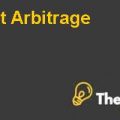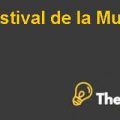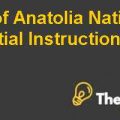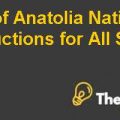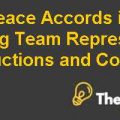
RJR NABISCO Case Solution
1. What was the value of RJR Nabisco under?
a) The pre-bid operating strategy?
b) The Management Group's strategy?
c) KKR's operating strategy?
ANSWER:
On excel sheet.
3. Evaluate the Special Committee's use of an auction of RJR Nabisco?
After receiving unexpected bid, board of directors typically makes an announcement that the offer "does not serve shareholders' best interests." That announcement is soon followed by solicitations for other offers, once it becomes apparent that the firm will be acquired. RJR's board proved an exception to this process: It played an active role in structuring the bidding rules, monitoring and adjusting the bidding process, and choosing the winning bid. We summarize below the board's active participation in the process.
The board defined its task not as just getting the best immediate price for RJR, but as ensuring that shareholders did not get locked out of possible future gains. It did so by stating that one of its considerations was the proportion of stub equity left in public hands.
The board defined its fiduciary duty broadly, considering not only shareholders' interests, but also the welfare of its primary stakeholders die company's employees and its communities. By making its preferences known, the board implied that it would evaluate factors other than merely the Bid price, such as the extent of asset sell-offs, the number of employees fired and the stock equity component remaining in the public hands.
The board, in an unusual move, immediately criticized as unacceptable management's first offer to invest only $20 million for an 8.5 per cent stake in the company (with an option to raise the stake to 20 per cent).
The board asked interested bidders to submit two bids one for the whole company and one for the tobacco business only. This gave it more flexibility and also enabled it to fetch a better valuation for RJR. In addition, the board was concerned that, because of the size of the transaction, some of the bidders would cooperate rather than compete with each other. It therefore asked for a sealed bid, thus discouraging alliances between groups. Typically, in a leveraged buyout plan, the acquiring group attempts to secure buyers for assets it plans to sell. To avoid this, RJR's board emphasized that it would not allow potential bidders to "pre-sell" businesses that is, obtain commitments in advance to divest themselves of the company's businesses.
Prior to the first round of bidding, the board announced that the bidding deadline would not be extended. This put time pressure on the bidders' advisers, by then already overwhelmed by the extent of information they had to analyze.
Following the first round of bidding (with firm offers including KKR's $94 a share and management's $100), the advisers to the board's special committee gathered the bidders in an informal discussion, suggesting $100 a share as the floor for the next round of bidding. On the surface, it seemed like a risky strategy, which could scare off all the bidding groups. But the board had an alternative plan break up RJR on its own.
As events unfolded, the more aggressive strategy prevailed. The board advisers informed the bidders (prior to the second round), that the board members were prepared to unveil their own restructuring plan unless bids for RJR surpassed the restructuring estimated value, believed to be at least $100 a share.
4. Which bid should the special committee select, if any? What other actions should the special committee take?
By traditional standards, RJR management should have won the bidding war. Its offer, $112 a share, was higher than KKR's by nearly $700 million, its cash portion of the offer ($84) was higher than KKR's ($81), its members were all industry experts with an intimate knowledge of the company, and management was on good terms with the board members. Nevertheless, when the bidding ended, traditional factors did not determine the winner. The management group lost. The following factors led to the ultimate victory of KKR's lower bid.
The Break-Up Factor: The board's five-person special committee wanted to keep the company as intact as possible and minimize turmoil and negative effects on employees. While KKR promised to keep the tobacco and most of the food business intact, the management group planned to keep only the tobacco business (see Table Z). Indeed, KKR specified that it would sell only $5 to $6 billion of RJR assets in the near future. The management group intended to sell the entire food business for an estimated $13 billion. Keeping its options open, KKR did not disclose its longer-term plans.
The Equity Factor: The board's five-person special committee wanted to provide existing share- holders with an option to participate in the buyout and thus share in any future KKR profits from the transaction. The desire was to leave some stub portion of the company's stock in public hands. While KKR proposed to distribute 25 percent of the equity in the future company to existing shareholders, the management group offer included only 15 per cent. Financing Structure: As Table Z shows, both groups offered a combined $28 a share in the form of either exchangeable preferred stock and debentures (KKR's offer) or preferred stock and addition^ convertible stock (management's offer). However, based on an analysis performed by the advisers to the board's special committee, KKR was offering $500 million more equity than the management group. This, again, accommodated the board's objective of maximizing cur- rent shareholders' participation in future profits.
Employment Commitment: In its effort to be responsible to all stakeholders, the board's special committee wanted to minimize adverse effects on employees. While KKR's offer guaranteed severance and other benefits to employees who lost their jobs because of layoffs, management's proposal focused on giving equity to 15,000 employees. Though these two proposals were not comparable in value, the board believed that KKR's plan was potentially more remunerative for the employees.
Post-LBO leadership: The intensive bidding war affected all parties’ involved management, employees, communities and the bidders themselves. During the bidding period, the uncertainty was high and business was affected. In the interest of restoring stability, the board's special committee assessed each offer in terms of its effects on RJR's identity and culture. KKR quickly read the board's mind and announced its plan to install J. Paul Sticht as the company’s chairman and CEO. He had been in these positions in the 1970s and early 1980s and was known for emphasizing the company's responsibility to stakeholders primarily employees and communities. Alternatively, the management group proposed to let F. Ross Johnson continue as RJR's CEO. For various reasons (including poor handling of his own PR) the board associated Mr. Johnson's group with greed, lavish spending, and insensitivity to employee and community needs.
On a purely monetary basis, the two offers were very dose; the final decision was based on other factors. KKR was attuned to the board's goals and the impact on other stakeholders such as employees and communities. It also recognized that financial, but not immediately quantifiable, factors as well as the acquiring group’s goodwill would play decisive role.
Transforming a complex set of financing instruments into a simple estimate of the cost of capital requires many approximations and simplifications. Moreover, the assumptions underlying the valuation process must be carefully assessed and modeled.
The RJR buyout is a classic example of how the bidding process itself can affect the outcome. In particular, the board's role in setting the bidding rules minimized the possibility of collusion and thereby increased potential gains to both shareholders and the firm's other stake- holders. In addition, KKR's well-structured sequential bidding strategy may well provide a role model for future buyouts.
Agency cost and LBO:
These are the costs of the agent who arrange the buyer of the business for the seller. In other
words the agent brings the buyer and seller together in order to buy or sale the business. For
this purpose the agent charges a fee also known as agency cost. The cost is not so big; it is the
minimal cost or sometimes a percentage of the selling price / selling value. RJR Nabisco is a
good Leverage buy out company, as it is generating positive returns. Its debt to equity ratio is
64%. So it is using cheap source of finance to earn good returns.
Analysis of the valuation:
When they consider the old method of operation of the business then the value of the business
is $31.2 billion. This is because the interest they will pay is less than the other two operating
strategy. We could see that the revenue by following old strategy is higher because this
includes the revenue from the food sales as well. So, in 1998 they will be able to earn revenue
of approximately $34.2 billion.
But if they sell the food segment and focus on their core tobacco business then their total
revenue will fall which will reduce the value of the company. It could also be said that the RJR
Nabisco will have to pay less interest if they continue its operations. So, the management’s new
strategy will increase their financial risk as well. So, the increase in interest and reduction in
total revenue has an impact on the valuation of the company and thus the new value will be
approximately $ 21 billion.
The KKR thought that RJR Nabisco has over valued its food segment’s sales projection. So, it
estimated pessimistic values of the food segment’s sales. This has reduced the value of the
company by $ 5 billion. The KKR also incorporated high interest rate in the valuation of the
company. This has further reduced the profitability of the company. So, by using KKR
assumptions and forecast the value of the company is $ 26 billion.
Evaluation of special committee auction:
The special committee has incorporated 4 main points / terms for the auction.
Special committee in order to protect the rights of the share holders stated that for the sale of
the segment it is not conditional that RJR Nabisco will sell its assets. This will ensure that they
will only sell the segment and the assets related to it. None other assets of RJR will be sold.
They have incorporated another condition to secure the rights of the share holders that the sale
of the segment of the RJR Nabisco will not be against the interest of the share holders.
They have also incorporated that whoever is bidding for the food segment should also tell the
source of finance they will use and the consideration they will make for the proposal.
Furthermore they have incorporated that it is the right of the board of directors whether to
accept or reject the proposal. No penalty will arise on boards’ decision.
These are the good terms which they have incorporated into the auction so that the bidding
party will remain aware of the boundaries in which they have to carry out the bidding process.
Selection of a bid:
The RJR Nabisco should select the highest bid by considering the easy payment method. For the
bid they must be aware of the sources of finance as well so that they will be aware that
whether they are able to pay us or not.
KKR is considering to pay $ 22.6 billion with share price of $75/share. But RJR Nabisco is
expecting to receive $90/ share. But the payment terms of KKR is same as the RJR Nabisco
wants, but KKR is paying less amount for the purchase of the business.
First Boston Group is paying $98 to $110 per share and further securities valued at $5 and $2
to $3 warrant. So, as compare to KKR which is offering $75/share this offer is more favorable
for RJR Nabisco, but First Boston Group has not told the sources from which it will finance the
purchase of the business.
So, RJR Nabisco should ask First Boston Group for the sources to finance the purchase of the
business. If in case it will deny then, they should contract to ensure that the RJR Nabisco will
receive the payment from First Boston Group. RJR Nabisco should select First Boston Group as
it is paying sufficient amount which is in the interest of the RJR Nabisco as well as their share
holders.
Gives students the opportunity to explore the issues facing the board of directors in leveraged buyout. RJR Nabisco is valued at different work strategies and source of income by borrowing emphasized. "Hide
by Richard S. Ruback Source: HBS Premier Case Collection 12 pages. Publication Date: May 15, 1989. Prod. #: 289056-PDF-ENG

